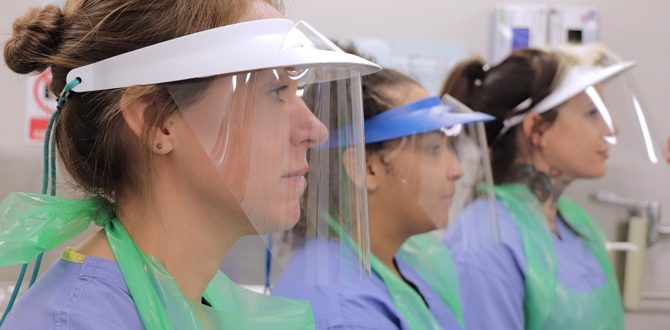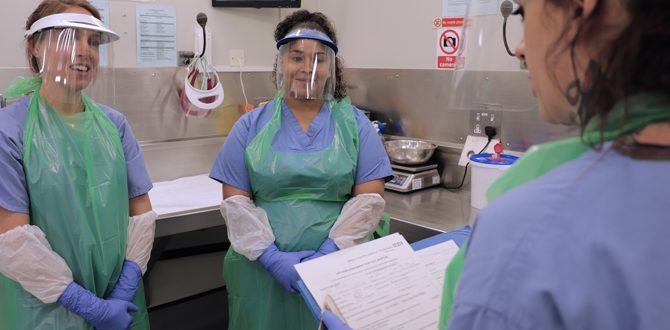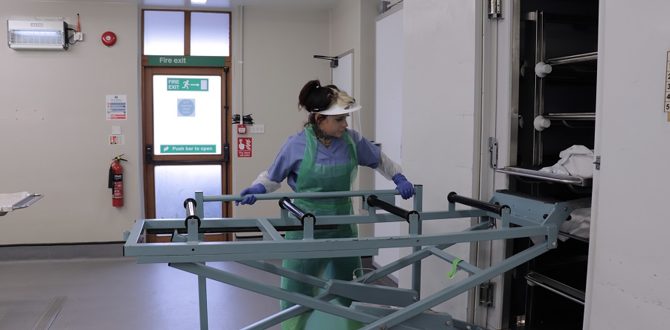Post mortems are crucial to understanding why people die and are vitally important in advancing our understanding of disease. When someone dies, it can be a very difficult, distressing and confusing time for their friends and family. The College sets high standards for post-mortem examinations, which include carrying out the post mortem in a respectful manner and with regard for the feelings of the bereaved relatives.
The mortuary team at West Herts were nominated for an RCPath Excellence Award by Dr Adam Goodchild, ST6 Histopathology. We asked Adam why he nominated them.
‘I have had the pleasure of working with the mortuary team at Hemel Hempstead Hospital throughout my training – first while rotating to the hospital and then returning to gain more experience while based elsewhere. The team are friendly, attentive and dedicated. They understand the challenges of post mortem for pathology trainees and know when to step in and offer a helping hand.’
Keen to find out more, we visited the mortuary to meet the team and talk to them about their service.
Would you like to start by introducing yourself?
I am Katie Tomkins, the Mortuary Manager, and I have been at West Herts NHS Trust for just under eight years. I have been an Anatomical Pathology Technologist (APT) for over 20 years.
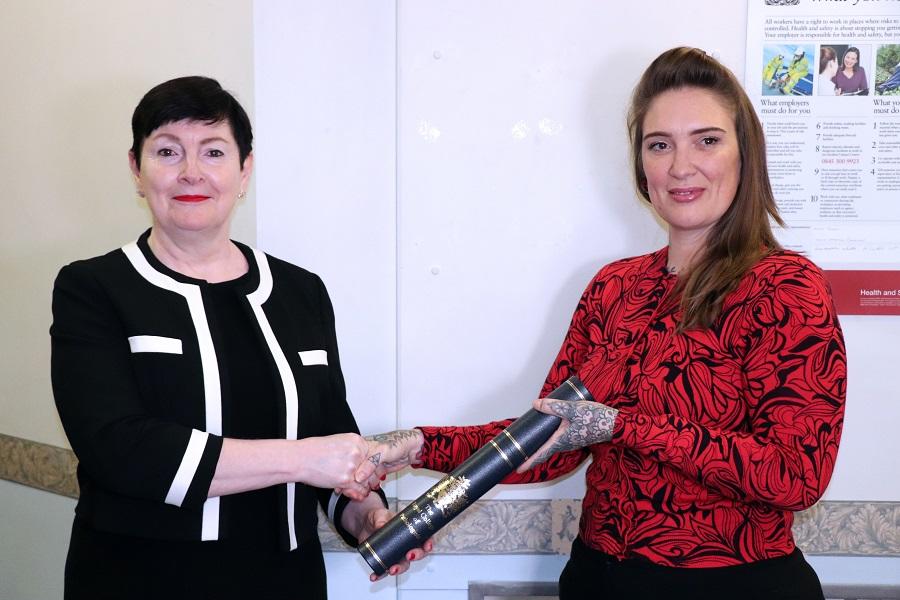
Could you tell us about the setup of the mortuary team – how many people are at the mortuary and what are their job roles?
We are a team of five, working across two trust sites. I am the Mortuary and Post Mortem Services Manager and Qualified Anatomical Pathology Technologist (APT), Laura O’Malley is the Deputy Mortuary Manager and Level 3 Diploma Qualified APT, Ruth Abdellah is the Senior APT and Level 3 Qualified APT and Caroline Jones and Denis O’Malley are both Trainee APTs.
The team work across two sites, with trainee APTs taking a weekly rotation at each site. There is a mortuary at Watford that is predominately a body store that handles 1,800 deceased patients a year. Watford can be a very busy site so the APTs spend their day admitting and releasing deceased, dealing with enquiries and preparing deceased patients for viewings.
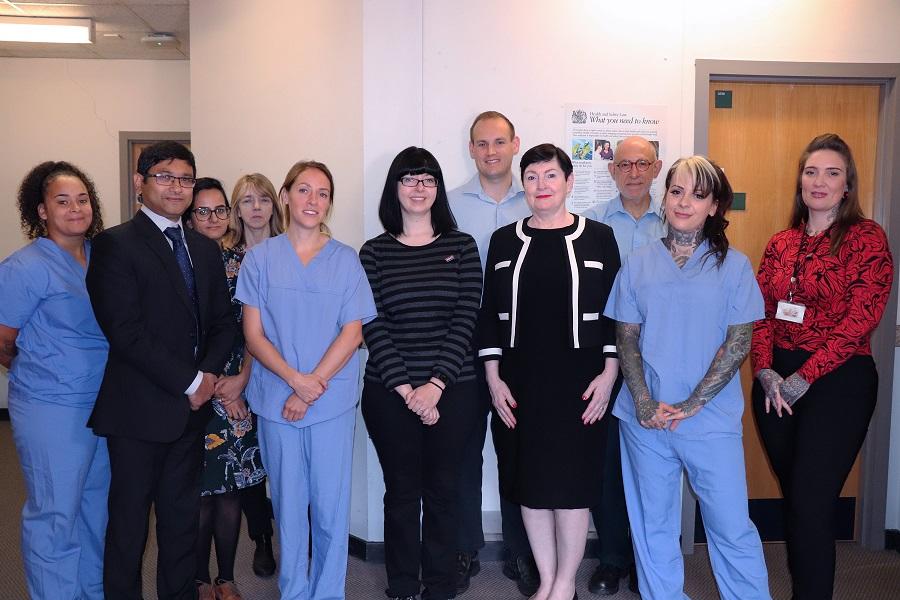
Hemel Mortuary acts as the coroner’s mortuary for West and South Hertfordshire – the mortuary conducts post-mortem examinations on behalf of the coroner. The APTs spend their day assisting at post-mortem examinations, booking in deceased and completing records. They also arrange viewings and formal identifications – meeting the families and guiding them through the viewing process.
The mortuary acts as the forensic centre for Hertfordshire and will facilitate forensic examinations as soon as they are requested, so we do sometimes need to shuffle the daily work and the team around to prevent any delays.
Describe an average day for the mortuary?
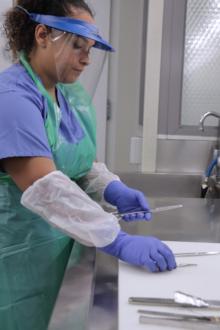
There isn’t a typical day and that’s one of the things we all love about this profession. We never quite know what we are coming in to each morning. Deceased patients are admitted to our department 24 hours a day by either the porters or the undertakers – some mornings when we arrive, we have had no new admissions; other days, we can come into a very large number of new admissions and some very interesting complex cases.
We have to organise our time well to ensure that we can manage and care for our new admissions as well as complete the post-mortem cases that we had arranged the day before.
The post mortems often take up the whole morning, in between taking phone calls and dealing with undertakers collecting deceased.
The morning is a flurry of work: we start in the post-mortem room at 8am and conduct on average five to six post mortems per day. The staff will get everything set up and – if required – eviscerate the deceased for the consultant. The post mortems often take up the whole morning, in-between taking phone calls and dealing with undertakers collecting deceased.
When we have a trainee pathologist, we can have two working in the post-mortem room at the same time along with the consultants. Depending on the skill level of the trainee pathologist, they may be allocated an APT to stay with them throughout the evisceration process to offer assistance and guidance.
How do you encourage learning and engagement among the visiting trainee pathologists and the team?
When a trainee pathologist either chooses to continue with the post-mortem part of the speciality or we see that spark of interest in a visiting ST1, we will jump on them (in a nice way).
We teach best practice evisceration techniques when taking toxicology and we demonstrate advanced techniques like vertebral artery exposure. They get involved in every aspect of the autopsy process.
We treat everything as a learning opportunity.
We push them to learn as much as they can and try as much as they can and utilise the skills and the knowledge of the APTs. If we have an interesting case or some unusual pathology and the trainee pathologists are not in the post-mortem room, we will call them in to come and see. We treat everything as a learning opportunity.
We will encourage them to watch high risk cases, making them think about what they would do if they were given such a case. Our visiting forensic pathologists will allow the trainees to observe post mortems on suspicious cases.
What do you think makes the biggest difference in creating a positive environment in the mortuary?
We try to create a very friendly, relaxed working atmosphere; we know that mortuaries and post-mortem examinations are not for everyone – even if they have chosen to pursue a career in pathology.
The mortuary staff talk openly about cases that have affected us, so that everyone knows it’s okay not to always be okay.
We treat the new trainee pathologists as part of the team, asking them about their weekend, films, music and so on – as we would talk to each other. The mortuary staff talk openly about cases that have affected us, so that everyone knows it’s okay not to always be okay.
What are the biggest challenges facing the service and what steps have you taken to overcome them?
We have seen an increase in post-mortem work over the last few years. This puts pressure on us as a team and department, as the department has had to increase its overflow capacity on both sites to prevent capacity breaches in winter. We work hard to meet our targets for the turnaround of coroners’ post-mortem requests to prevent delays for the families. However, this often results in the team being in the post-mortem room all day conducting higher numbers of cases, and that in turn has an effect on the other work we need to conduct to maintain the smooth running of the department.
How do you ensure, as a team, that the service is always as good as it can be?
As a team, we have set key performance indicators for a number of elements – our main focus will always be the family of the deceased. We will always try to conduct a post-mortem examination within 24 hours of the request and we try to facilitate viewings of the deceased on the same day as the request or within 24 hours.
The team peer audit the manager, as it’s important the whole team are working to the same high standard.
We use a six-sigma method to track our performance. The results are shared at the monthly Pathology Quality Forum and we are challenged on poor or reduced performance. There is a planned audit schedule that covers all the Human Tissue Authority standards and individual competencies. The team also peer audit the manager, as it’s important the whole team are working to the same high standard.
Is there anything you do that is unique to your mortuary service?
As a team and department we never say no – we can’t do that.
There are so many great learning experiences for the mortuary team and the pathologists – because of our we-can-do-it attitude, visiting trainee pathologists get to see and experience a wide variety of post-mortem cases and techniques.
I am very passionate about the mortuary, anatomical pathology and autopsy practice. I try to instil that passion into the team and into everything we do. That’s what makes us and our service unique.
The College's Service Spotlight blog series showcases services that have made impressive changes in their practice that improve quality and/or patient safety. This is the second blog in the series. If you would like to nominate a service that you think should be highlighted, please email [email protected].

